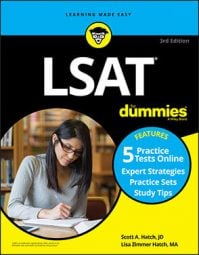A key to successfully answering logical reasoning questions is to understand how the LSAT uses certain words. The LSAT logical reasoning section applies these terms in a near-mathematical sense. Finding the correct answers to certain questions depends on the way the test-makers use these terms.
Quantity terminology
Make sure you’re familiar with terms that indicate quantities:
None: This one is easy. None means none, absolutely none, not even one.
One: One means one. Enough said.
Some: Some is at least one but less than all. If you encounter a question that uses both some and most, assume that they may mean the same thing.
Many: The definition of many is even less clear than the one for some. It's safest to treat it the way you would some.
Most: Most means more than half.
All: All refers to every group member.
Every: Every means every member of a group, just like all.
The main thing to remember with quantity terms is this: They’re usually used relative to one another. So a question that mixes the terms some, most, and all may expect you to compare the three. All is clear; it encompasses everything. Most is often less than all but more than some. Additionally, a characteristic that’s true of some, many, or most members of a group could be true of every member of a group. For example, it’s true that all the faces on Mt. Rushmore are of men, but it’s equally safe to say that some of the faces are of men. Consider a relative qualifier such as some, many, or most to provide you with a foundation for evaluation but not an absolute.
Reasoning verbs
The verbs included in a question provide clues to the correct answer. Make sure you understand exactly what these reasoning actions require:
Assume: To take for granted that something is true, without proof; the noun form is assumption.
Conclude: To reason one’s way to a judgment or decision; the noun form is conclusion.
Deduce: To draw a logical conclusion by reasoning from available facts; the noun form is deduction.
Discrepancy: A difference, incompatibility, or lack of agreement between two or more statements.
Explain: To describe an idea and its facts in such a way as to make it clear; to provide reasons or justifications for some phenomenon; the noun form is explanation.
Imply: To suggest a conclusion without stating it directly; a conclusion that can be drawn from something not directly stated can be called an implication.
Infer: To use evidence and reasoning to reach a conclusion that isn’t directly stated; the noun form is inference.
Presume: To assume; to suppose that something is true based on available evidence, but not necessarily direct proof; the noun form is presumption. Lawyers and judges often talk about presumptions, which are basically the same thing as assumptions but sound fancier.
Reconcile: To make two things consistent with each other; to restore harmony; the noun form is reconciliation.
Support: To furnish evidence or reasons that make a conclusion seem more likely.

